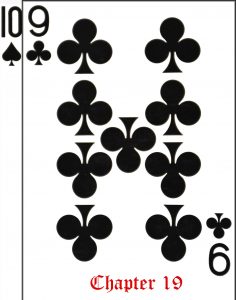Defence (left of declarer) leads to the first trick.  This sets up the flow of information between partners, and to get it wrong will surely give the Game away! The opening lead has the best potential to defeat a contract, so it is an advantage not to be squandered.
This sets up the flow of information between partners, and to get it wrong will surely give the Game away! The opening lead has the best potential to defeat a contract, so it is an advantage not to be squandered.
So which card should you lead to the first trick? There are some common best practices, and they need to be understood and agreed upon by both partners.
Leading to a suit contract
There are three types of suit:
- A suit headed by two or more touching honour cards such as: ♠ Q J 7 or ♦ K Q J 3
- A suit headed by a single honour card, not touching: ♥ A 6 3 or ♣ Q 9 4 2
- A suit of small cards: ♦ 9 5 4 2 or ♣ 8 6 3 2
In a nutshell:
- Lead from the top of a sequence such as: ♠Q or ♦K
- Lead a low card from a suit with one honour: ♥3 or ♠2 Note that a lead of ♥6 might be better if you want to “encourage” the lead back to your ♥A, for example.
- Lead the top card of a suit with no honours: ♦9 or ♣8, the “top of nothing”, as it is sometimes called. [But see the MUD convention, briefly described below]
By leading the top of an honour sequence, you are promising the next card. So in the above example, leading the King from ♦ K Q J 3, promises partner you also hold the Queen. Note that when you are facing a suit contract a King lead will deny holding the Ace.
If you have a doubleton, play high-low. This reverse lead is also called a “peter”. Partner will pick up on this later and realise you have developed a useful void. From a ♠ 9 6 holding you should lead the ♠9, then drop the six the next time the suit is played. Similarly, with ♦ J 7 lead with the ♦J. When you play the ♦7 this will signal partner you had a doubleton allowing you to ruff future diamond leads.
With touching honours you can also lead high-low, first the acefrom A-K, or the king from K-Q. But if the honours are not touching you cannot use the high-low signal as with any A-x right down to 10-x.
Incidentally, you can also use the high-low signal to encourage partner to lead back to your preferred suit.
With a three-carder, from A-K-x or K-Q-x you should lead the King in both cases. This will tell partner that you either have the Ace or that you are promoting your Queen.
MUD
MUD is a lead convention and means “middle up down”. It is made to signal a worthless three-carder. So with ♠8 6 5, instead of the natural lead of top of nothing, first lead out the middle card (♠6), then the top card (♠8). If you get a third round the 5♠ will tell partner you had a three-carder and are now void. The same message would be clear to an astute partner if, having played the ♠6, you discarded the 8 followed by the five. Discarding is when you are unable to follow suit so you can play any card from another suit except trumps.
To continue reading go to: Long suit leads
Further pages in this chapter are:
Leading to a NT contract
In Play – Declarer
Squeeze and finesse
In play -strategy
Discarding
By Nigel Benetton – based on the UK Acol Bridge Bidding System
Last updated: Sunday, 4th July 2021